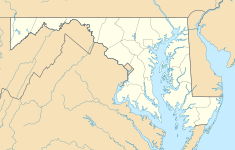
Bolton Hill is a neighborhood in Baltimore, Maryland, with 20 blocks of mostly preserved buildings from the late 19th century. It is listed on the National Register of Historic Places, preserved as a Baltimore City Historic District, and included within the boundaries of Baltimore National Heritage Area. The neighborhood is bounded by North Avenue, Mount Royal Avenue, Cathedral Street, Dolphin Street, and Eutaw Place. Bolton Hill is a largely residential neighborhood with three-story row houses with red brick, white marble steps, and high ceilings. There are also larger more ornate originally single-family houses, many houses of worship, parks, monuments, and a few large apartment buildings. Many significant residents have lived in the neighborhood, including F. Scott Fitzgerald, Woodrow Wilson, the Cone sisters, and Florence Rena Sabin.

Lafayette Square is a neighborhood in St. Louis, Missouri, which is bounded on the north by Chouteau Avenue, on the south by Interstate 44, on the east by Truman Parkway, and on the west by South Jefferson Avenue. It surrounds Lafayette Park, which is the city's oldest public park — created by local ordinance in 1836.

The Episcopal Diocese of Maryland forms part of Province 3 of the Episcopal Church in the United States of America. Having been divided twice, it no longer includes all of Maryland and now consists of the central, northern, and western Maryland counties of Allegany, Anne Arundel, Baltimore, Calvert, Carroll, Frederick, Garrett, Harford, Howard, and Washington, as well as the independent city of Baltimore.
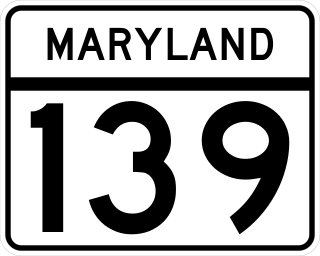
Charles Street, known for most of its route as Maryland Route 139, runs through Baltimore and the Towson area of Baltimore County. On the north end it terminates at an intersection with Bellona Avenue near Interstate 695 (I-695) and at the south end it terminates in Federal Hill in Baltimore. Charles Street is one of the major routes through the city of Baltimore, and is a major public transportation corridor. For the one-way portions of Charles Street, the street is functionally complemented by the parallel St. Paul Street, Maryland Avenue, Cathedral Street, and Liberty Street.

The Church of the Ascension and Saint Agnes is an Episcopal church building located at 1215 Massachusetts Avenue in Northwest Washington, D.C., US. The current structure built in 1874 as the Church of the Ascension was added to the National Register of Historic Places in 1984. In the late 1940s, the Church of the Ascension merged with the nearby St. Agnes Episcopal Church and adopted its present name, under which it has continued as an active parish in the Episcopal Diocese of Washington.
St. Paul United Methodist Church is located in the historic Grant Park neighborhood of Atlanta, Georgia. For a time in the early 1900s, St. Paul had the largest Methodist congregation in the Southeastern United States. The church organ was acquired at the Cotton States Exhibition in 1887. St. Paul's stained glass windows, which date back to 1907, are being refurbished. St. Paul is a main stop on tours of the Grant Park neighborhood given by the Atlanta Preservation Center. St. Paul is also home to the Grant Park Cooperative Preschool. St. Paul, the Grant Park Cooperative Preschool and the Grant Park Parent Network host the annual Grant Park Candlelight Tour of Homes, which also includes an artist marketplace and a Winter Wonderland for children. The Candlelight Tour of Homes begins at St. Paul.
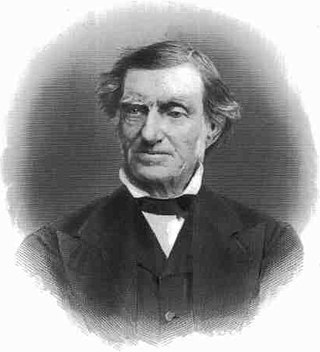
Thomas Kelso was an Irish-American philanthropist and businessman, who was born in Clones, a market town in the north of Ireland, August 28, 1784. He died on the morning of July 26, 1878 at his home of many years on East Baltimore Street in Baltimore, Maryland, at the age of 94.

The First Unitarian Church is a historic church and congregation at 12 West Franklin Street in Mount Vernon, Baltimore, Maryland. Dedicated in 1818, it was the first building erected for Unitarians in the United States. The church is a domed cube with a stucco exterior. The church, originally called the "First Independent Church of Baltimore", is the oldest building continuously used by a Unitarian congregation. The name was changed in 1935 to "The First Unitarian Church of Baltimore " following the merger with the former Second Universalist Church at East Lanvale Street and Guilford Avenue in midtown Baltimore. The American Unitarian Association and the Universalist Church of America (established 1866) representing the two strains of Unitarian Universalism beliefs and philosophies merged as a national denomination named the Unitarian Universalist Association in May 1961.
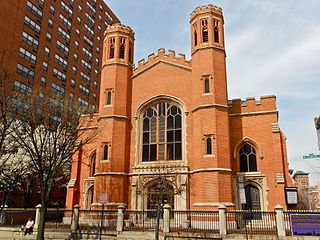
Franklin Street Presbyterian Church and Parsonage is a historic Presbyterian church located at 100 West Franklin Street at Cathedral Street, northwest corner in Baltimore, Maryland, United States. The church is a rectangular Tudor Gothic building dedicated in 1847, with an addition in 1865. The front features two 60 foot flanking octagonal towers are also crenelated and have louvered belfry openings and stained glass Gothic-arched windows. The manse / parsonage at the north end has similar matching walls of brick, heavy Tudor-Gothic window hoods, and battlements atop the roof and was built in 1857.
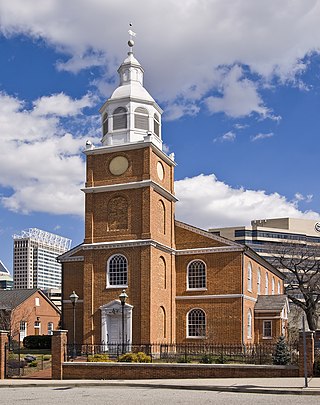
Otterbein Church, now known as Old Otterbein United Methodist Church, is a historic United Brethren church located in Baltimore, Maryland, United States. The first "German Reformed" church was built to serve the German Reformed and some Evangelical Lutheran immigrants, and later entered the Brethren strain of German Reformed Protestantism in the later Church of the United Brethren in Christ.

St. Paul's Protestant Episcopal Church, more commonly called Old St. Paul's Church today, is a historic Episcopal church located at 233 North Charles Street at the southeast corner with East Saratoga Street, in Baltimore, Maryland, near "Cathedral Hill" on the northern edge of the downtown central business district to the south and the Mount Vernon-Belevedere cultural/historic neighborhood to the north. It was founded in 1692 as the parish church for the "Patapsco Parish", one of the "original 30 parishes" of the old Church of England in colonial Maryland.

Lovely Lane United Methodist Church, formerly known as First Methodist Episcopal Church and earlier founded as Lovely Lane Chapel, is a historic United Methodist church located at Baltimore, Maryland, United States.
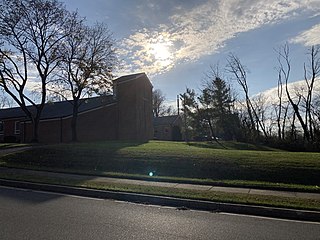
Bishop Cummins Reformed Episcopal Church is a Reformed Episcopal Church congregation in Catonsville, Maryland. Founded in 1874, the building it occupied in Baltimore from 1879 to 1961 is listed on the National Register of Historic Places under the name Cummins Memorial Church.

Leadenhall Street Baptist Church is a historic Baptist church located at Baltimore, Maryland, United States. It is a gable-front rectangular brick temple with simple Renaissance Revival detail. The original exterior wall surfaces have been covered with formstone on the main façade and stucco elsewhere. It features round-arched stained glass windows on each side bay. It was built in 1873, by Joseph Thomas & Son for the city's African American Baptists who were then centered in the old southwest area from the downtown business district of Baltimore in the "Sharp-Leadenhall" community in the old "South Baltimore" area. Nearby is its now famed revitalized "Inner Harbor" area of the old "Basin" for the harbor port.
Charles L. Carson, was an architect born in Baltimore, the oldest son of Daniel Carson, a builder, and one of the founders of the Baltimore chapter of AIA. Carson had little formal training as an architect. Around 1870 he partnered with Thomas Dixon (architect) while taking drawing lessons at the Maryland Institute College of Art. Carson and Dixon worked from their offices at 117 Baltimore Street as Thomas Dixon and Charles L. Carson until sometime before 1877 when the partnership was dissolved. In 1888 he hired Joseph Evans Sperry who became his chief assistant, and later his partner and successor.

"Mount Winans" is a mixed-use residential, commercial and industrial neighborhood in the southwestern area of the City of Baltimore in Maryland. Its north, south and east boundaries are marked by the various lines of track of the CSX Railroad. In addition, Hollins Ferry Road running to the south towards suburban Baltimore County in the southwest and further connecting with adjacent Anne Arundel County to the southeast, draws its western boundary.

The Bethel A.M.E. Church, known in its early years as Indianapolis Station or the Vermont Street Church, is a historic African Methodist Episcopal Church in Indianapolis, Indiana. Organized in 1836, it is the city's oldest African-American congregation. The three-story church on West Vermont Street dates to 1869 and was added to the National Register in 1991. The surrounding neighborhood, once the heart of downtown Indianapolis's African American community, significantly changed with post-World War II urban development that included new hotels, apartments, office space, museums, and the Indiana University–Purdue University at Indianapolis campus. In 2016 the congregation sold their deteriorating church, which will be used in a future commercial development. The congregation built a new worship center at 6417 Zionsville Road in Pike Township, Marion County, Indiana.
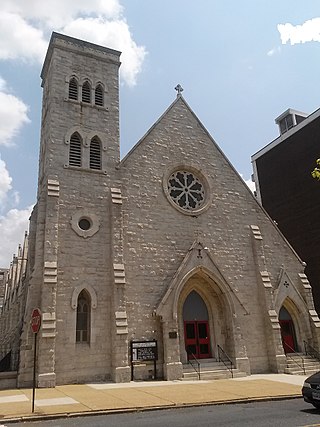
St. James Episcopal Church Lafayette Square, or St. James African Episcopal Church, founded in 1824, is a historic Episcopal church now located at 1024 W. Lafayette Avenue in the Lafayette Square Historic District of Baltimore, Maryland.

Midtown-Edmondson is a mixed-use neighborhood in western Baltimore City developed mostly between the 1880s and the 1910s. The neighborhood is mainly composed of residential rowhouses, with a mixed-used business district along Edmondson Avenue, and industrial warehouses and buildings dotted along the CSX railroads that bound its western edge.

Grace & St. Peter's Church is an Anglo-Catholic Episcopal parish in the city of Baltimore, in the Episcopal Diocese of Maryland. The congregation is the product of the 1912 amalgamation of two earlier parishes, St. Peter's Church and Grace Church. Its building, constructed in Brownstone, is an elaborate example of English Gothic Revival architecture dating from 1852. Today, Grace & St. Peter's is distinguished by its Anglo-Catholic liturgy and professional choir. From 1940 to 2020, it was also home to the Wilkes School at Grace & St. Peter's, an Episcopal day school which closed in the midst of the COVID-19 pandemic.

